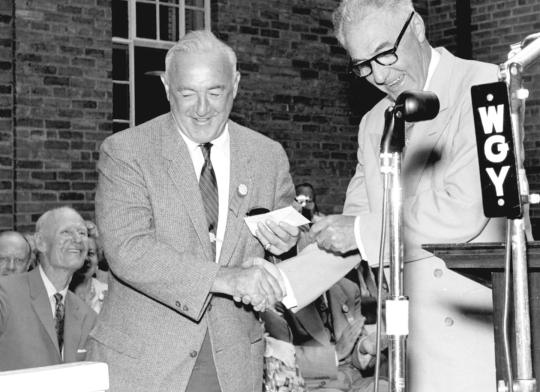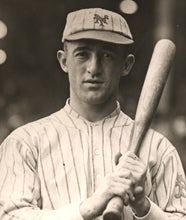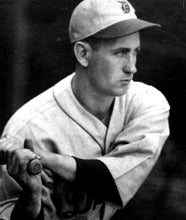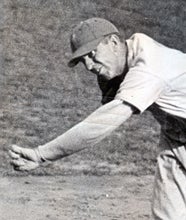- Home
- Our Stories
- Cochrane, Frisch, Grove and Hubbell elected to the Hall of Fame
Cochrane, Frisch, Grove and Hubbell elected to the Hall of Fame
After seeing just one player elected by the Baseball Writers’ Association of America during the first seven years of the 1940s, baseball fans were eager to have some of their favorite heroes gain election to the Hall of Fame.
On Jan. 21, 1947, those fans got their wish when a historically large group of inductees was announced.
“You can say one thing about the four gents newly elected to baseball’s Hall of Fame – they always had it when they needed it,” wrote Joe King in The New York World-Telegram.
“There cannot have been many players who could do a job in the pinch as well as Carl Hubbell, Frank Frisch, Mickey Cochrane and Lefty Grove.”
Those four inductees – Hubbell, Frisch, Cochrane and Grove – represented the second-largest class selected by the BBWAA, trailing only the original induction class of 1936.
After World War II canceled several elections in the first half of the decade, the sudden spike in inductees was brought about by two significant rule changes. First, votes were limited only to writers who had been BBWAA members for at least 10 years – a rule that is still in place today. Second, the voters – who had previously failed to single out worthy candidates from a massive pool of players who had appeared after 1900 – were now asked to only consider candidates from the previous 25 years.
“The choice therefore was not spread over a 47-year period,” King explained, “and current writers were not asked to match players of recent times to shadowy figures of the past they had never seen.”
In addition to all its historical significance, the 1947 class featured a brilliant battery and a pair of New York Giants legends.
Robert Moses “Lefty” Grove retired in 1941 as one of the greatest left-handed pitchers the game has ever seen. Finishing with an even 300 wins, Grove still holds the highest winning percentage (.682) among 300-game winners. He posted eight seasons with 20 wins or more, captured a record nine ERA titles and led the American League in strikeouts six times. In 1931, Grove used his blazing fastball to string together 16 consecutive victories. That season was Grove’s finest, as he finished with remarkable 31-4 record and a 2.06 earned run average.
“I only caught him at the end,” said Hall of Famer Ted Williams, Grove’s teammate with the Boston Red Sox from 1939-41, “but nobody could throw a baseball any harder.”
Grove’s rise in stature coincided directly with that of his catcher, Cochrane, with the Philadelphia A’s.
“Hardly ever shook him off,” Grove said of Cochrane. “Funny, before I’d even look at him, I had in my mind what I was going to pitch and I’d look up and there’d by Mickey’s signal, just what I was thinking. Like he was reading my mind. That’s the kind of catcher he was.”
Cochrane, one of the fiery leaders of an Athletics club that won three consecutive pennants and two World Series championships from 1929-31, batted .345 during Philadelphia’s dynastic seasons and finished with a .320 career average. He captured American League Most Valuable Player honors in 1928 with Philadelphia and again in 1934 with the Detroit Tigers, who he would later lead to two pennants and a World Series title as player-manager.
“Cochrane was a great inspirational leader,” said the Tigers’ Hall of Fame second baseman Charlie Gehringer. “Boy, he was a hard loser, the hardest loser I think I ever saw. He wouldn’t stand for any tomfoolery. He wanted everybody to put out as hard as they could and he set the example himself.”
The other two inductees in 1947 shared a connection as well. Though they never played together, Frisch and Hubbell will be forever linked as the catalysts for two different eras of championship success at the Polo Grounds.
Nicknamed the “Fordham Flash,” Frisch was a scrappy second baseman who terrorized pitchers both at the plate and on the basepaths. He led the National League in steals in 1921, hits in 1923 and runs scored in 1924, all while leading the Giants to four straight pennants and two World Series titles. He would later capture two more rings as a member of the St. Louis Cardinals’ vaunted “Gashouse Gang.”
“There may never have been a fiercer competitor than Frisch, a money-player and clutch performer without a peer,” claimed Arthur Daley of The New York Times. “He could hit for a higher average and a greater distance. He covered more territory afield than a space cadet. He was a swift and daring base-stealer. He was a great player without a weakness.”
After Frisch was traded to the Cardinals for Hall of Famer Rogers Hornsby in 1926, Hubbell maintained the Giants’ success with some of the most phenomenal pitching performances in baseball history.
Hubbell captured the first of two NL MVP awards in 1933 after sporting a miniscule 1.66 ERA, setting the stage for his most famous achievement the following July.
After allowing a hit and a walk to begin the 1934 All-Star Game at the Polo Grounds, Hubbell electrified the home crowd by striking out the next five AL All-Stars with his baffling screwball. The list of punchout victims is memorized by historians and diehard baseball fan alike: Babe Ruth, Lou Gehrig, Jimmie Foxx, Al Simmons and Joe Cronin.
“If you didn’t know what he threw, it was almost impossible to hit him,” Hall of Famer Billy Herman said of his teammate Hubbell. “He was one of the greatest pitchers I’d ever seen.”
Matt Kelly is a freelance writer from Brooklyn, N.Y.
Catcher's mitt used by Mickey Cochrane - B-438-66 (Milo Stewart Jr./National Baseball Hall of Fame Library)
Share this image:
Support the Hall of Fame
Mentioned Hall of Famers
Related Stories

Bob Feller pitches the first of 12 career one-hitters

Uncommonly Sweet

Joe DiMaggio makes his big league debut, recording three hits in the Yankees’ win

Goslin’s walk-off clinches Tigers’ first title

Hall of Famers arrive in Cooperstown to start baseball’s best weekend

Just the Ticket for Cobb

Making of a Legend

Philadelphia A’s trade Jimmie Foxx to the Boston Red Sox

King John Schuerholz
Cap Selection Announced for Randy Johnson
01.01.2023
Curtain Rises on Hall of Fame Weekend as Ozzie Smith and Friends Return to PLAY Ball
01.01.2023




















